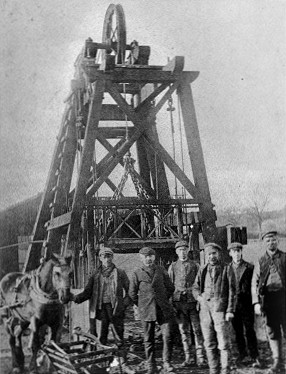The coal seams come to the surface in the Efail Isaf area and so the coal reserves were amongst the first to be worked. There was no need to dig very deep but the ground was very wet and the conditions were difficult. Whilst building the new Tonteg by-pass remains of some of the earliest pits could be seen at Nant Celyn, Bryn Menyn and Ystrad Barwig.
Yn 1699 Edward Llwyd wrote about the coal workings in Castellau and Rhiw Saeson and there were many coal workings in the parish of Llanilltud Faerdref. They were small coal mines for heating houses, brewing beer and burning lime for agricultural purposes.
The Vicar of Llantrisant informed Edward Llwyd “Coal works have been and are diged up in severall place, those that are viz, Mase mawr & bryn y menin.” Hefyd mewn ateb i Edward Llwyd dywedodd Charles Jevans o Dyffryn Dowlais “Coale works very numerous in most gorunds in the parish. Att Bryner menin is a fine coale that burns bright & yet is lasting to wch. being mixt with the coale dugg at Cystelle makes a godd bright & a lasting fire tryed by my self this sumer, but Brynne menin of itself is not soe lasting but affords a bright fire. Coale likewise at maes mawr & maes bach.”
By 1793 the owners of the Pentyrch Ironworks had purchased leases for coal mines at Dihewyd and Tir yr Eglwys.
Thomas Powell, who was developing coal mines in the Cynon Valley and Rhondda, owned Llantwit Colliery in 1845. He opened four pits, two at Dihewyd, one at Ystrad Berwig (near the Ship) and one at Tynynant.
Also pits were opened by other owners in the 1860’s - Corporation Land Colliery, Llantwit Wallsend Colliery, Gelynog Llantwit Colliery amd the Llantwit Mine Colliery which was opened by David Jones in 1855.
The coal mines went into decline during the depression in the mid 1870's.
There were coal mines to the south of Efail Isaf at Tynycoed and Craig Gwilym and to the east at Gedrys and Maes Mawr.






